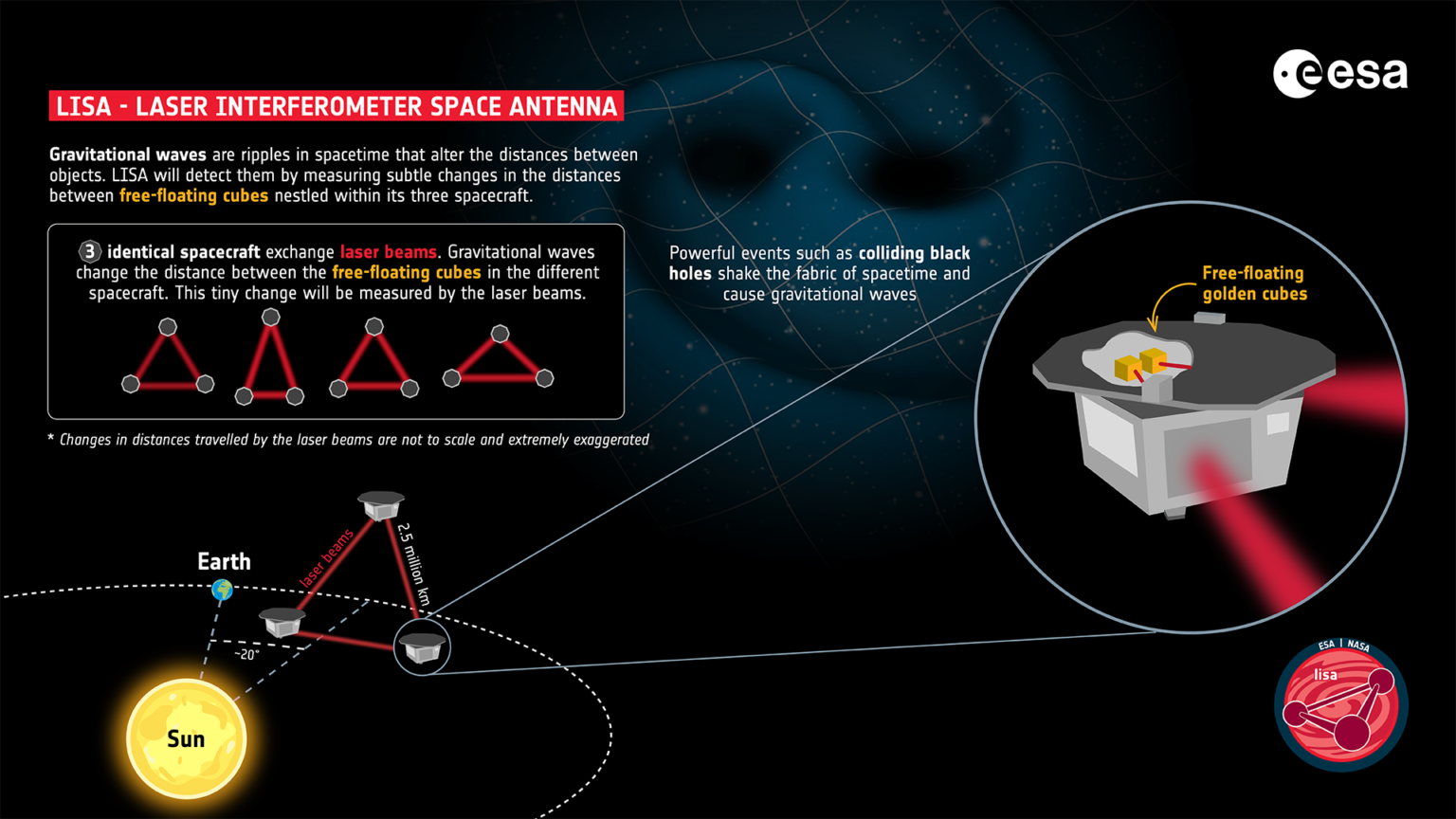23.06.2025

ESA celebrated its 50th birthday at this week’s Paris Air Show, signing agreements for future space missions, releasing a space technology vision, and reinforcing its association with the European Union. One of NASA’s oldest partners, ESA is moving forward despite global uncertainty in general and cooperation with NASA in particular. The deep cuts in President Trump’s FY2026 budget request could affect many NASA-ESA joint programs including NASA’s participation in the space-based gravitational wave detector LISA. Nonetheless, ESA optimistically signed an agreement with OHB to begin LISA’s construction.
ESA was established in 1975 as the merger of the European Space Research Organisation, ESRO, and the European Launcher Development Organisation, ELDO. The original 10 members — Belgium, Germany, Denmark, France, United Kingdom, Italy, the Netherlands, Sweden, Switzerland and Spain — were quickly joined by Ireland. Over the past 50 years, another 12 have joined. Slovenia became the 23rd in January 2025.
Cooperation with NASA has been a mainstay of ESA’s activities throughout the decades both in science and human spaceflight. That would change if the Trump Administration’s FY2026 NASA budget requestbecomes budget reality with its $6 billion (24.3 percent) cut to NASA’s budget overall, including a 47 percent reduction to science. Instead of the $24.8 billion NASA received for FY2025, it would get $18.8 billion for FY2026 and remain at that level, unadjusted for inflation, through FY2030.
Reacting to news of the impending cuts, ESA Director General Josef Aschbacher said ESA remains open to cooperation with NASA, but would assess the impacts. Looking only at the space science portfolio, ESA Director of Science Carole Mundell said at a press conference last week that of the 19 joint programs right now, ESA can “potentially mitigate” the impacts on 16 of them, but not three others — LISA, the EnVision Venus probe, or the NewAthena x-ray space telescope.
Aschbacher remains optimistic, repeatedly pointing out that NASA’s budget request is just that, a request, and the final amount Congress will provide is yet to be determined. This week he announced that ESA and OHB Systems AG just sealed their agreement to build LISA and the press release listed NASA as one of the partners.
LISA, the Laser Interferometric Space Array, is an ESA-led project to search for gravitational waves from space, expanding on measurements possible with ground-based instruments. In 2015, the United States became the first country to directly detect gravitational waves using the twin Laser Interferometer Gravitational-wave Observatory (LIGO) detectors in Hanford, Washington and Livingston, Louisiana funded by the National Science Foundation (NSF). Caused by the collision of two black holes 1.3 billion light years away, the observation confirmed Albert Einstein’s prediction that intense cosmic collisions produce ripples in the fabric of space-time, opening a new field of cosmology. American scientists Rainer Weiss, Barry C. Barish, and Kip S. Thorne won the 2017 Nobel Prize in Physics for their contributions to LIGO.
Detecting gravitational waves from Earth has limitations, however. Putting an observatory in space allows detection of events at lower frequencies — milliHertz instead of tens to hundreds of Hertz. LISA will consist of three spacecraft precisely positioned 2.5 million kilometers (1.5 million miles) apart exchanging laser beams that will detect even the slightest change in the distance between two masses — “golden cubes” — inside each spacecraft that will indicate if they’ve been affected by gravitational waves.
After the successful LISA Pathfinder technology demonstration mission in 2015, ESA selected LISA as part of its Cosmic Visions program in 2017. ESA’s Science Program Council approved it in 2024 with launch expected in 2035.
NASA agreed to provide three critical pieces of hardware — lasers, telescopes, and charge management devices — as well as develop a science ground segment. Last year’s NASA budget request included $414 million for LISA from FY2025 to FY2029. This year’s request is zero.
NASA told SpacePolicyOnline.com that the agency plans to deliver instrument prototypes to ESA before the end of FY2025. The telescope prototype was delivered in October and the laser and charge management system prototypes are expected to be delivered before FY2026 begins on October 1. At that point funding will end if the FY2026 budget proposal is adopted.
Thomas Zurbuchen, former NASA Associate Administrator for the Science Mission Directorate, told SpacePolicyOnline.com that LISA is “truly civilization-scale science” that “promises to allow us to observe the universe in an entirely new way, extending the pioneering observations of LIGO into a different regime.” ESA will have “to decide whether they do LISA alone or wait for NASA in the hopes things change later on,” but the U.S. science community will be the “biggest victim” if the United States walks away.
“The biggest victim of such a severed collaboration would be the U.S. science community which pioneered gravitational wave astronomy and will be relegated into the role of spectators as Europe takes over.” — Thomas Zurbuchen
Science programs across the government would be hard hit by the Trump Administration’s budget proposal. NSF’s budget is being cut even more drastically than NASA’s and would terminate one of the two LIGO detectors as well.
NASA would still retain several significant space science programs, but it is a far cry from what was planned just a few months ago. Casey Dreier, Chief of Space Policy for The Planetary Society, told SpacePolicyOnline the Trump Administration’s budget proposal cedes U.S. leadership to others.
“NASA’s abrupt retreat from its commitments with ESA is yet another reminder that the FY 2026 budget process is unprecedented, unstrategic, and wasteful. Instead of investing in cutting-edge scientific and technical fields for space science, this budget instead cedes U.S. leadership to other nations. … There is little new scientific opportunity proposed in this budget; it is a policy of inertia, of giving up on wide swaths of the cosmos; its meagre ambitions are in direct contradiction with the President’s stated goals of U.S. preeminence in all areas of spaceflight.” — Casey Dreier
Conversely, ESA is boldly looking forward and not only in space science. They also released the “Technology 2040: A Vision for the European Space Agency” report at the Paris Air Show this week — a “call to action” with plans for a “resilient European presence across Earth orbit and beyond.”
By contrast, the Trump Administration’s FY2026 budget request would cut NASA’s Space Technology Mission Directorate in half, from $1.1 billion to $569 million.

ESA’s budget and programs are determined by government ministers from its member states at Ministerial Council meetings every three years. The next meeting, CM25, will take place in November.
ESA will be asking for €20-23 billion ($23-26.5 billion) for the next three years, a significant increase from the €16.9 billion approved in 2022, which itself was a 17 percent increaseover the budget approved in 2019. ESA also gets funding from the European Union to design and build EU space systems like Copernicus for earth remote sensing and Galileo for navigation. ESA and the EU are cementing their ties amid plans to buttress European autonomy and resilience in space.
In short, while ESA’s budget may be modest compared to NASA’s, it is going up, not down, and Europe’s ambitions are expanding. As Dreier said, a waning NASA budget appears to be “in direct contradiction with the President’s stated goals of U.S. preeminence in all areas of spaceflight.”
Quelle: SpacePolicyOnline.com
